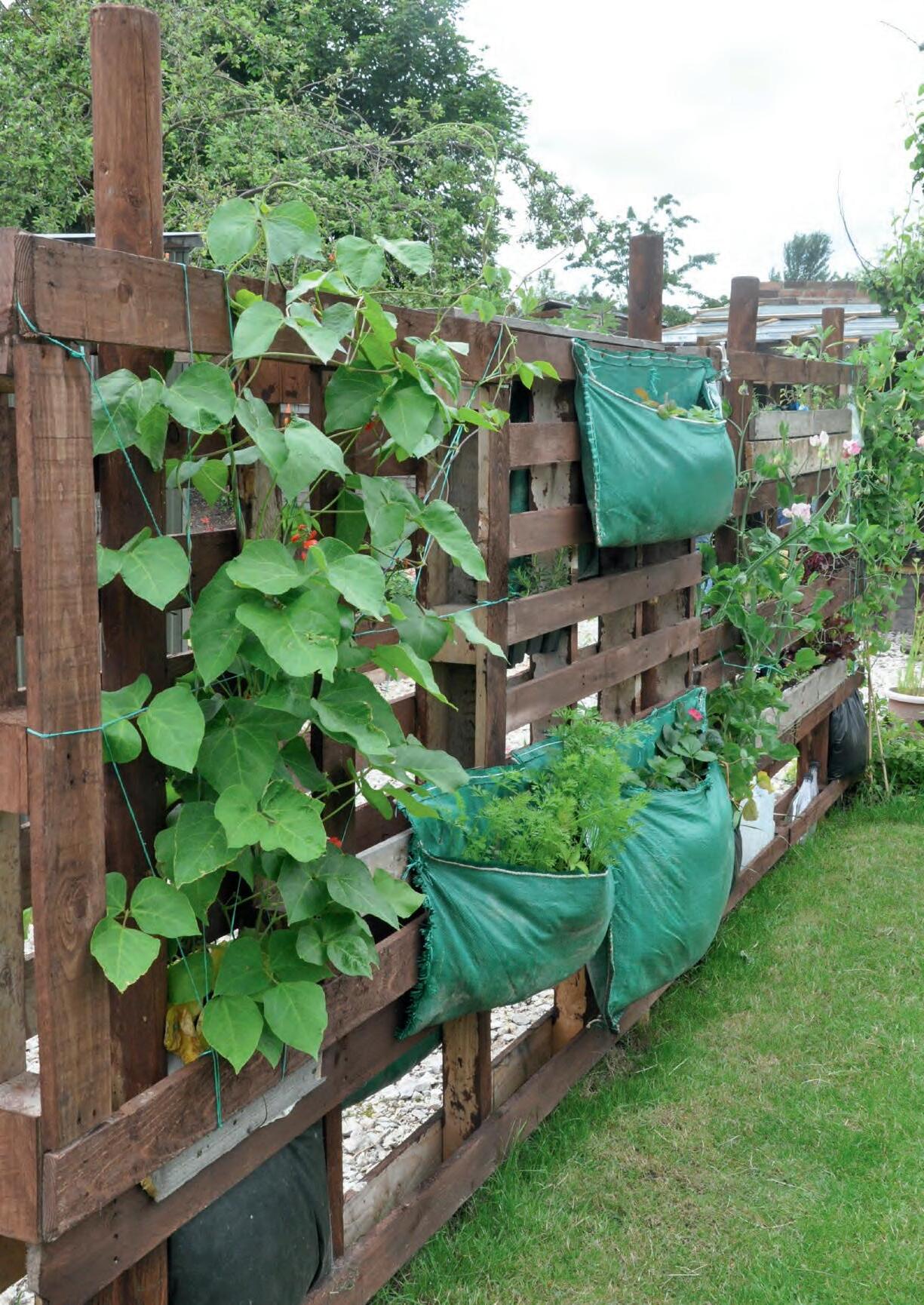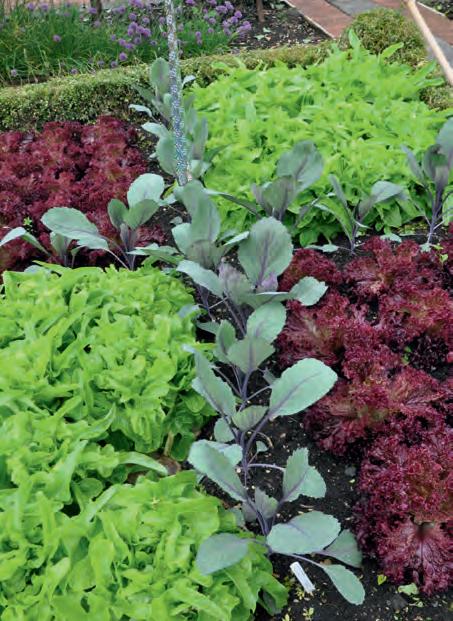
4 minute read
SMALLBUT PERFECTLY FORMED HOW TO GROW

If you don’t have a lot of room to grow, there are many ways to maximise crops from tiny places. Here are some ideas

Edible Corner
This picture shows that in a small sunny corner you can create something attractive but productive. Planted at the back is an espalier fruit tree. You can buy young, trained trees, or you could pay a lot less and buy what is known as a one-year maiden tree, which will tend to be a single stem with few or no sideshoots. You then take the top out and encourage sideshoots to form and train these horizontally to form the branches.
At the base of the tree is rosemary. is will eventually get too big for this space, but it can be kept smaller by regular pruning and using the clippings in cooking. Also in this bed is red-veined sorrel, a perennial plant that comes up every year. e very young leaves can be added to salads to give a slight lemony tang. Older leaves can be cut and cooked like spinach. Add a viola for their edible owers and you have an interesting little productive corner.
Hanging Troughs
For something a bit more uniform and stylish you could x several small troughs to a wall or strong fence. ese have been planted with lettuce and tiny bush tomatoes. All vertical plantings do need careful watering. Rainfall is often shielded from these planters so do check regularly. Ideally, keep to a height to make checking soil moisture and watering easy.

Pallet Planting
Pallets are great for increasing your growing area. Secure them strongly to a wall to stop them falling forward. You can remove one or two planks and reattach under the slats to form a rudimentary planting box. You can either drop small pots into the box or ll with multipurpose compost and sow or plant up. is pallet has a mixture of crops, including herbs such as thyme, lemon balm and also kale and pansies to add colour. You could also plant several dwarf bush tomatoes with trailing nasturtiums and basil to make a really attractive pallet garden.

Vertical Lift






Using vertical spaces around your plot will vastly increase its growing area. is beautiful living wall has been created using scrap wood and pallets. Runner beans grow through it at one end and sweet peas the other. Old sacks have had their tops sewn up then been turned on their sides, with one long side opened up to create a planting pocket. To securely hold the sack with the weight of compost and plants, it would be best to batten and screw it to the wall. You could grow a wide range of crops in the pockets. Pictured are carrots (stump-rooted types work best), strawberries and salads.

Fruit Tree Double Act
is fruit tree has been underplanted with lettuces. When fruit trees are rst potted on into large pots you will nd the base is a perfect area for some shallow rooted veg such as salad leaves. is space can be planted as long as the tree is getting enough water and occasional feeds. Many little spaces like this soon add up to

Pack Them In
When you have a small area you can often experiment with crop spacing. Sometimes you can get away with having plants a bit closer together, giving you a bigger overall harvest. So long as water and nutrients are in plentiful supply and plants are not too shaded, it is worth just bending the rules a little on spacings.
Potted And Plentiful
Growing in containers is a great way to grow veg if you don’t have much space. A balcony, patio or tiny backyard can be very productive. Growing in pots is also ideal if you rent and don’t want to ‘put down roots’ or you are restricted in what you can do in the garden. You can grow in pretty much anything that holds compost and has holes in the bottom for drainage. In this picture, along with traditional pots, is a homemade trough made from recycled planks of wood. It may not be the prettiest container but it’s still a perfect home for some strawberry plants.


Just Bootiful




Even an old pair of boots can hold some compost and therefore some fruit or veg plants – in this case two strawberry plants.

Block Planting

Sometimes making the best use of odd-shaped pieces of land requires a bit of creative thought. Why should vegetables be in rows? Sow in blocks instead. In this case patches of green and red lettuce have been sown around a cross-planting of brassicas. ey are close together but the lettuce will be harvested before the brassicas because the latter need the extra space to grow on. Growing quick-to-mature lettuce around slower-growing crops like brassicas is also known as intercropping – a great way to increase harvests from one space.
Bagged Up
If you don’t have much space, you could buy some growing bags and sow them with a whole range of veg. Growing bags would t down a narrow alleyway or in a corner of a sunny patio. Simply break up the compacted bag by punching it and moving it around. Place it where you want it then put some holes into the bottom. Cut out the plastic on the top in a rectangular shape and then sow. Lettuce and mixed salad leaves do well in growing bags. In the picture the bag contains spinach plus a round-rooted carrot called ‘Atlas’, but you could also grow ‘Parmex’.


All Together
If you haven’t the space to devote solely to vegetable growing but have a ower border, why not just grow them all together? is both beautiful and edible space has a wigwam of runner beans and, around it, brassica and beetroot plants, plus yellow tagetes, orange marigolds and nasturtiums for a splash of colour. Also note the feathery foliage of cosmos, which will be topped with a mass of pollinator-attracting owers come midsummer. e tall purple Verbena bonariensis is a great bee attractant and as it is a spindly plant will not shade out your veggies. You could also dot in some purple kale plants and patches of spinach with lettuce at the front of the border.




